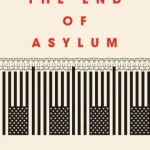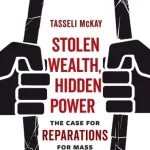Tangled Up in Blue: Policing the American City
 Author: Rosa Brooks
Author: Rosa Brooks
Publisher: Penguin Random House, 2022. 384 pages.
Reviewer: Tung Yin | March 2023
A few years ago, I jumped at the opportunity to experience the shooting simulator at the local sheriff department’s Public Safety Training Center. It occurred to me that experiencing a realistic simulation of potentially dangerous scenarios would provide some useful insight when teaching criminal procedure doctrines that are predicated on the need to prioritize officer safety over the strict demands of search warrants. I wrote a short article about the experience and what I learned from it (Yin, 2018).
My little excursion was a drop in the bucket in terms of experiential research compared to the five years that Georgetown University law professor Rosa Brooks spent as a reserve officer with the Washington, D.C. Metropolitan Police Department. In Tangled Up in Blue: Policing the American City, Professor Brooks provides a personal account of her experience, beginning with the process of deciding to apply to the reserve officer program, continuing with her training at the police academy, and then diving into a wide variety of encounters during those five years of patrolling.
At the outset, it is important to emphasize Professor Brooks’ goal in writing this book. It would seem natural for a law professor teaching courses in criminal procedure and human rights to publish a book about “the problems that plague modern policing” or one “analyzing police shootings or examining the role of racial discrimination in the criminal justice system” (pp. 16–17). She chose not to do so in part because she felt she had little to add on those scholarly topics beyond what has already been written, and because telling the stories of what she experienced as a reserve officer can highlight the complicated, rather than over-simplified, nature of American policing (p. 18).
Part One of Tangled Up in Blue is subtitled “Because It Was There,” and that is a pithy summary of what led Professor Brooks to apply to be a reserve police officer. Interestingly, she did not set out to write a book at the beginning of the process. Instead, her motivation was essentially curiosity: “I just…wanted to see what being a police officer was like at such a fraught moment” (p. 16). The decision to apply to the program, however, was not without controversy among her peers or family. In particular, her mother—Barbara Ehrenreich, the famous author of Nickel and Dimed: On (Not) Getting By in America (in which Ehrenreich worked minimum wage jobs for three months to see if one could survive on such meager pay)—strongly disapproved: “[G]o interview some cops. You don’t need to become a cop” (p. 42).
Part Two, “The Academy,” describes the police training program. For fifty weeks, Professor Brooks and her fellow reserve recruits attended training classes on Tuesday and Thursday evenings from 6:30pm to 10:30pm and on Saturdays (except the first Saturday of the month) from 8am to 4:30pm, along with 80 hours of firearms training and 40 hours of vehicle skills (p. 49).
For those readers with an interest in police reform, the chapters in this part of the book are a fascinating glimpse into how police officers are made—at least, in Washington, D.C. Given her day job as a law professor, it is hardly surprising that Professor Brooks received criticism for writing reports that were too detailed: “The more you write, the more likely you are to say something that gets you in trouble. Less is more” (p. 74). She also had to overcome resistance to the passive voice (p. 74).
No discussion of policing can avoid the issue of “officer safety,” which provides one of the justifications for the all-important search incident to arrest exception to the warrant requirement. Professor Brooks spends an entire chapter on the “chief lesson learned at the academy…: Anyone can kill you at any time” (p. 79). One would think that watching footage of police officers in jeopardy for weeks on end would be enough, but the recruits went out of their way to look up more such videos to watch (and share) during their spare time (pp. 79–80). This emphasis on officer safety may be understandable given the inherent dangers of law enforcement, but it may also contribute to a quicker tendency to use force because, as one instructor told the recruits, “you have the right to go home at the end of the day” (p. 87). Indeed, she notes that the recruits “had all been ‘killed’ during scenario-based role-playing sessions” (p. 126).
Even as Professor Brooks was going through this training program in 2016, there were several high-profile instances of Black men being killed by police. Although a frequent narrative in this cases is white police officers killing Black men, there are multiple instances in which the officers are people of color. (I am writing this review just days after five Black police officers beat Tyre Nichols to death.) While there are undisputed benefits to diversifying police forces, studies have found that doing so is not a panacea to the problems of police brutality and questionable killings of minority persons, especially young Black men (Bourie, 2014). The reasons for this dynamic are undoubtedly complex, but Professor Brooks provides some on-the-ground insight: “[i]t became natural to see the officer’s side of the story….We watched the same videos the rest of the country was watching, but by now, we had learned to see different things” (p. 126). This coupled with a nearly complete lack of classroom discussion meant that the recruits were only talking about race and policing on their own, and “it was clear that most recruits weren’t comfortable talking about race. We were all blue now, weren’t we?” (p. 125).
Part Three, “The Street,” encompasses more than half of the book and showcases a variety of calls that she responded to during her five years as a reserve officer. Some of them are funny, like the driver who needed help getting a spider out of her car (pp. 182–83). Other instances demonstrate at a minimum that society should want more police officers who evince a degree of empathy, as Professor Brooks did toward the underdressed female prisoner who needed transportation from the police station to the hospital. Brooks helped the prisoner deal with a wardrobe malfunction, apologized for having to handcuff the prisoner to the bed rail at the hospital (and did so as gently as possible), and found a blanket and water for the prisoner (p. 163).
Perhaps the most intense and riveting chapter in the book details a potential burglary call that Professor Brooks and her partner responded to one evening. When Brooks and her partner arrived at the property in question, the door was slightly open even though the alarm company had reported that no one should be inside. Both officers drew their firearms and proceeded with caution, only to be startled by someone who popped into the hallway and then disappeared again. Professor Brooks recounts that “[i]n the simulations we went through during firearms training and our twice-a-year re-qualification courses, this was the kind of situation in which bullets immediately started to fly…” She had no intention of shooting, but she did not know how her partner would react (p. 314).
As it turned out, no bullets were fired and the matter was resolved without trouble. But Professor Brooks points out that she and her partner took on extra risks in how they handled the incident:
We could have called for backup. We could have done a tactical room-clearing. We could have kept our guns at the ready position, our fingers on the triggers. We could have shouted at the kid to get down on the floor, cuffed him, and kept him cuffed until we were sure there were no weapons or other potential assailants present (p. 316).
How Professor Brooks and her partner actually responded, compared to how they could have responded, may have been the difference between a non-incident and a justified but fatal shooting.
Not all of Part Three is fraught with such potential ramifications. Want to know what it’s like to be arrested? Professor Brooks provides a “you are there” account (p. 266–69). Want to know some of the special perks of being a police officer? She’ll tell you. There is an entire chapter devoted to domestic disputes between mothers and daughters, an incident involving drag-racing ATVs on the streets of D.C., a well-being check on someone who gave his name as Dracula and said he was being abducted by aliens and the Mafia, and more.
Finally, what did Professor Brooks take from the experience? Although she has not written a book with policy proposals or critical analysis of law enforcement pathologies, at the end of her time as a reserve police officer, she proposed to a police official a new program that would bring newcomers to the Washington, D.C. police force as fellows. Those participants would meet “in monthly workshops on topics such as race and policing, implicit bias, poverty and crime, D.C.’s changing demographics and the impact of gentrification on policing,” and more (p. 332). This was called the Police for Tomorrow initiative, and it launched in 2017.
This is a thoroughly enjoyable book to read, even as parts of it chronicle the sad plight of the D.C. underclass. Professor Brooks has a lively writing style with moments of self-deprecating humor mixed with introspection about good policing and bad. Anyone who is interested in reading about, thinking about, or more importantly discussing policing reform should read Tangled Up in Blue. (They should also experience the shooting simulator.) Although Professor Brooks does not provide any detailed academic theories or policy analysis, what she has written is in some ways more valuable, because good theories and policy ultimately rely on facts on the ground. There is plenty of material in this book suggesting that policing reform is a complex matter requiring nuance—how police officers are selected and trained plays an important role, and so too does the mindset of police officers in the field.
References:
Jamelle Bouie, Black and Blue: Why More Diverse Police Departments Won’t Put an End to Police Misconduct, Slate, (Oct. 13, 2014), https://slate.com/news-and-politics/2014/10/diversity-wont-solve-police-misconduct-black-cops-dont-reduce-violence-against-black-citizens.html.
Tung Yin, The Perspective of the Reasonable Officer on the Scene: My Trip to the Shooting Simulator, 16 Ohio St. J. Crim. L. 207 (2018).
Tung Yin is a Professor of Law at Lewis & Clark Law School.


